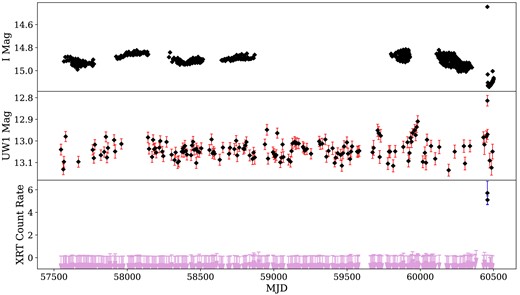2024-10-17 ペンシルベニア州立大学(PennState)
<関連情報>
- https://www.psu.edu/news/eberly-college-science/story/rare-ultra-luminous-nova-spotted-small-magellanic-cloud
- https://academic.oup.com/mnras/article/534/3/1937/7760382?login=false
CXOU J005245.0-722844:超高速超エディントンX線アウトバースト現象によるSMCのBe星/白色矮星連星系の発見 CXOU J005245.0−722844: discovery of a Be star/white dwarf binary system in the SMC via a very fast, super-Eddington X-ray outburst event
T M Gaudin, M J Coe, J A Kennea, I M Monageng, D A H Buckley, A Udalski, P A Evans
Monthly Notices of the Royal Astronomical Society Published:18 September 2024
DOI:https://doi.org/10.1093/mnras/stae2176

ABSTRACT
CXOU J005245.0−722844 is an X-ray source in the Small Magellanic Cloud (SMC) that has long been known as a Be/X-ray binary (BeXRB) star, containing an OBe main-sequence star and a compact object. In this paper, we report on a new very fast X-ray outburst from CXOU J005245.0−722844. X-ray observations taken by Swift constrain the duration of the outburst to less than 16 d and find that the source reached super-Eddington X-ray luminosities during the initial phases of the eruption. The XRT spectrum of CXOU J005245.0−722844 during this outburst reveals a supersoft X-ray source, best fit by an absorbed thermal blackbody model. Optical and ultraviolet follow-up observations from the Optical Gravitational Lensing Experiment (OGLE), Asteroid Terrestrial-impact Last Alert System (ATLAS), and Swift identify a brief <?XML:NAMESPACE PREFIX = “[default] http://www.w3.org/1998/Math/MathML” NS = “http://www.w3.org/1998/Math/MathML” />∼0.5 mag optical burst coincident with the X-ray outburst that lasted for less than 7 d. Optical photometry additionally identifies the orbital period of the system to be 17.55 d and identifies a shortening of the period to 17.14 d in the years leading up to the outburst. Optical spectroscopy from the Southern African Large Telescope (SALT) confirms that the optical companion is an early-type OBe star. We conclude from our observations that the compact object in this system is a white dwarf (WD), making this the seventh candidate Be/WD X-ray binary. The X-ray outburst is found to be the result of a very-fast, ultraluminous nova similar to the outburst of MAXI J0158−744.



